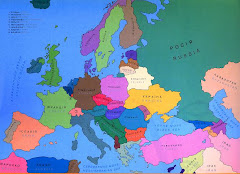 Barbara (with my luggage!) in front of the
Barbara (with my luggage!) in front of theCrimean Tartar Library; a lovely archway at the Library; a taste of Smferople.
I’m in Simferople, Crimea, visiting my PCV friend Barbara, who lives and works with the Crimean Tartar community. Simferople is a city of about 345,000, which feels huge coming from Starobilsk. Barbara lives in a neighborhod repopulated by returning Tartars who were kicked out of their Crimean homeland by Stalin in 1944. Here’s how she describes the community (www.crimeantartarlibrary.blogspot.com):
The Crimean Tatars are a Turkic Muslim people who inhabited the Crimean Peninsula—the southern land mass of Ukraine surrounded by the Black Sea and Sea of Asov—for over seven centuries. For three hundred years, from 1441 t

o 1783 when Crimea was annexed by Russia, the Crimean Tatars ruled the peninsula through the Crimean Khanate. At the height of the Crimean Khanate, there were over six million Crimean Tatars inhabiting the peninsula, and at the time of annexation to Russia, they constituted 98% of the population. The intense Russification of the peninsula over the next century forced many Crimean Tatars to leave their homeland, and by the time of the Russian Revolution, there were only 300,000 Crimean Tatars left on the peninsula. Under the Bolsheviks a brief flowering of Crimean Tatar culture occurred between 1921 and 1927, and Crimean Tatar was made the official language of the peninsula along with Russian.
 Stalin’s repressive policies soon ended this “Golden Age” and resulted in further devastation of the Crimean Tatar people and culture, culminating in the mass overnight deportation on May 18, 1944, of all Crimean Tatars to Uzbekistan and other distant Soviet Republics. Over 46% of the Crimean Tatar population died during transport and in the subsequent camps, and almost all evidence of Crimean Tatar culture—mosques, place names, art and literature—were destroyed in Crimea, leading to the desired final solution of a “Crimea without Crimean Tatars.”
Stalin’s repressive policies soon ended this “Golden Age” and resulted in further devastation of the Crimean Tatar people and culture, culminating in the mass overnight deportation on May 18, 1944, of all Crimean Tatars to Uzbekistan and other distant Soviet Republics. Over 46% of the Crimean Tatar population died during transport and in the subsequent camps, and almost all evidence of Crimean Tatar culture—mosques, place names, art and literature—were destroyed in Crimea, leading to the desired final solution of a “Crimea without Crimean Tatars.”Still, the Crimean Tatars--living in exile, not allowed to speak or teach their language, practice their religion, play their music, or write their stories--kept alive the dream of their homeland and formed a national movement which, after fifty years of nonviolent struggle, brought them back to their native land of Crimea. The Crimean Tatars slowly began to return in1985, a momentum that gathered strength as more and more restrictions were lifted, and in a 4-year period from 1989 to 1993, over 200,000 Crimean Tatars flooded back to Crimea. Today, an estimated 300,000 Crimean Tatars live in Crimea, constituting 13% of the population. They have an official governing body, representatives in the Crimea and Ukraine Rada (Congress), national schools that teach all subjects in Crimean Tatar, a university that educates Crimean Tatar language teachers, art and history museums, theater, radio and TV stations, and the Gasprinskiy Crimean Tatar Library where I so happily find myself working as a Peace Corps Volunteer.
For an excellent English-language website on the history and culture of the Crimean Tartars go to www.iccrimea.org.
The Gasprinskiy Crimean Tartar Library, named after a major turn-of-the-20th century Tartar writer who was far ahead of his time, is a major institution for this community, working to preserve the language and culture of the Tartar people. Barbara continues:
As Crimean Tatars flooded back to their homeland in the late 1980s and early 1990s, they began to establish organizations to serve their returning people. In 1990, the Crimean Tatar Library in the name of I. Gasprinskiy (known as the Gasprinskiy Library) opened as a branch of the central library system in Simferopol, the capitol of the Autonomous Republic of Crimea in Ukraine. Five years later, it became an autonomous library under the Ministry of Culture in Crimea.
The mission of the library is to acquire, store, and make available to users the world’s largest collection of documents in the Crimean Tatar language and about Crimean Tatars in other languages. Today, the library has a collection of more than 32,000 books plus 9000 complete sets of magazines and newspapers in the Crimean Tatar language; 4500 books in Turkish and other Turkic languages; and more than 2000 rare and valuable books.
Being with Barbara in Simferople is an adventure in itself, meeting her neighbors, sharing meals, and visiting the library.
On Saturday we went to the fabulous town of Bakhchysaray and visited the Khan’s palace, a building spared when Catherine the Great of Russia ordered the destruction of Crimean mosques, because it was a romantic and lovely structure, which it is; the Uspensky monastery, built into the limestone rock of the surrounding hill, most probably by Byzentine monks in the 8th or 9th century; and Chufut-Kale, one the best preserved and best-known cave towns of Crimea. Loren would have absolutely loved this area, and I got a feeling it may have been near or around the site of The Clan of the Cave Bear and other stories by Auel. Quite a hike, but well worth the effort to explore this fascinating place. More about Bakhchysaray later!




























No comments:
Post a Comment